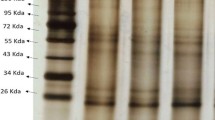Abstract
The eggs ofArgas reflexus were splashed with the LiCl and Na2Cr2O7 saturated solutions on the 2nd day after laying and were kept at 25° C and 30% RH.
Both examined chemical compounds caused great disturbances in embryogenesis ofArgas reflexus. Under influence of Na2Cr2O7 24.8% eggs died. The LiCl solution appeared to be more harmful on larvae development. 21.8% dead eggs, 11.6% dead embryos, and 8.9% larvae hatched abnormally were observed in these experiments
Zusammenfassung
Hemmende Faktoren bei der Embryonalentwicklung vonArgas (Argas) reflexus (Fab.) (Acari, Argasidae)
Die Eier vonArgas reflexus wurden am 2. Tag der Embryonalentwicklung bei 25° C und 30% r. L. der. Wirkung gesättigter Lösungen von LiCl und Na2Cr2O7 unterzogen.
Beide chemischen Verbindungen verursachten große Störungen der Embryogenesis vonArgas reflexus. Unter dem Einfluß von Na2Cr2O7 starben 24.8% der Eier ab. LiCl erwies sich als schädlicher für die Embryonalentwicklung dieser Zeckenart als Na2Cr2O7.
Bei den Experimenten mit LiCl wurden 21.8% Eier, 11.6% Embryos und 8.9% (abnormal geschlüpfte) Larven getötet.
Similar content being viewed by others
References
Booth, I. F., 1992: Observation on the composition and biosynthesis of egg wax lipids in the cattle tick,Boophilus microplus. Exp. Appl. Acarol,14, 137–49.
Buczek, A., 1988: Studies on the biology ofArgas (A.) reflexus (Fabricius, 1794) (Acari: Ixodida: Argasidae). 1. Effect of temperature and relative humidity on embryonic development and egg hatch. Folia Biol.36, 239–264.
Buckzek, A., 1991: Disturbances of the hatch larvae process ofArgas (A.) reflexus (Fabr.) Acari: Ixodida: Argasidae) caused by influence of different temperature and relative humidity levels. Wiad. Parazytol.37, 35–40 (in Polish).
Buczek, A., 1992 a: Studies on the biology ofArgas (A.) reflexus (Fabricius, 1794) (Acari: Ixodida: Argasidae). 2. Effect of alternating temperatures on embryonic development and egg hatch. Folia Biol.40, 151–153.
Buczek, A., 1992 b: Disturbances of embryonic development and egg hatch ofArgas (A.) reflexus (Fabricius, 1794) (Ixodida: Argasidae) caused by altering temperatures. Proc. II Symp. EURAAC, Krynica, August 31–Sept. 5, 1992, 17.
Buczek, A., 1992/1993: Effect of low temperature on the embryonic development and egg hatch ofArgas (A.) reflexus (Fabricius, 1794) (Acari: Ixodida: Argasidae). Z. ang. Zool.2, 249–254.
Buczek, A., 1993 a: Influence of iodine compounds on embryogenesis ofArgas (A.) reflexus (Fabricius, 1794) (Acari, Ixodida, Argasidae). Acta Parasitol.38, 41–43.
Buczek, A., 1993 b. Reduction in egg hatch ofArgs (Argas) reflexus (Fab.) (Acari, Argasidae) due to colchicine. Anz. Schädlingskde., Pflanzenschutz, Umweltschutz66, 131–134.
Buczek, A. in press: Anomalies inArgas reflexus (Fabr.) (Acari: Argasidae) collected from nature. Proc. IX Int. Congr. of Acarology, Columbus, Ohio, 17–22 July 1994.
Buczek, A.;Solarz, K., 1993: Attack the people byArgas (A.) reflexus (Fabricius, 1794) (Ixodida: Argasidae) Dangerous parasites for people and animals. Pol. Tyg. Lek.47, 238–239 (In Polish).
Chmelnicka, J., 1990: Metale i metaloidy. In Toksykologia (ed. Seńczuk W.) PZWL, Warszawa, 310–363.
Dautel, H.;Kahl, O.;Knülle, W., 1991: The soft tickArgas reflexus (F.) Acari, Argasidae) in urban environments and its medical significance in Berlin (West). J. Appl. Ent.111, 380–390.
Diehl, P. A.;Aeschlimann, A.;Obenchain, F. D., 1982: Tick reproduction: oogenesis and oviposition. In Physiology of ticks.Obenchain, F. D., Galun R. (eds.) Pergamon Press, Oxford, New York, Toronto, Sydney, Paris, Frankfurt, 277–350.
Dotson, E. M.;Connat, J.-L.;Diehl, P. A., 1991: Cuticle deposition and ecdysteroid titers during embryonic and larval development at the argasid tickOrnithodoros moubata (Murray, 1877, sensu Walton, 1962) (Ixodoidea: Argasidae). Gen. Comp. Endocrinol.82, 386–400.
Ehn A., 1963 a: Morphological and histological effects of lithium on the embryonic development ofAgelena labyrinthica Cl. Zool. Bidrag. Uppsala,36, 1–26.
Ehn, A., 1963 b: Effects of sulphydryl blocking substances on development of spider embryos. Zool. Bidrag., Uppsala36, 49–72.
Hafez, M.;Abdel-Malek, A. A.;Guirgis, S. S., 1971: The subgenusPerscicargas (Ixodoidea: Argasidae:Argas). 12. Biological studies on the immature stages ofA. (P.) arboreus Kaiser, Hoogstraal et Kohls in Egypt. J. Med. Ent.8, 421–429.
Harper, H. A., Rodwell, V. W.;Mayes, P. A., 1979: Review of Physiological Chemistry. Lange Medic. Publ. Drawer L, Los Altos, California.
Lees, A. D., 1948: Passive and active water exchange through the cuticle of ticks. Discuss. of Faraday Coc.3, 187–191.
Lees, A. D.;Beament, J. W. L., 1948: An egg-waxing organ in ticks. Ql. J. Microsc. Sci.89, 191–232.
Ludwig, M.;Kratzmann, M.;Alberti, G., 1992/1993: The influence of some heavy metals onSteganacarus magnus (Acari, Oribatida). Z. ang. Zool.4, 455–467.
Melchakova, I. D., 1972: Development ofOrnithodoros tartakovskyi in different temperatures and relative humidity. Trudy Inst. Zool., An Kazakh. SSR33, 124–129 (in Russian).
Rogers, C. E.;Howell, D. E., 1971: Responses of the fowl tickArgas radiatus to compounds of cadmium and antimony. Ann. Ent. Soc. Am.64, 258–63.
Siuda, K., 1981: Investigations on the biology of the tickArgas (Argas) polonicus Siuda, Hoogstraal, Cliford et Wassef, 1979 (Acarina: Ixodides: Argasidae). 3. Effect of temperature and relative humidity on embryonic development end egg hatch. Folia Biol.29, 9–39.
Winston, P. W.;Bates, D. H., 1960: Saturated solutions for the control of humidity in biological research. Ecology41, 232–237.
Witalinski, W., 1987: Egg-shells in mites. Cytological aspects of vitelline envelope and chorion formation inPergamasus barbarus Berlese (Gamasida, Pergamasidae). Int. J. Acarol.13, 189–196.
Witalinski, W., 1988: Egg-shells in mites. Vitelline envelope and chorion in a water mite,Limnochares aquatica L. (Acari, Limnocharidae). J. Zool., Lond.214, 285–294,
Witalinski, W., 1993: Egg shells in mites: vitelline envelope and chorion in Acaridida (Acari). Exp. Appl. Acarol.17, 321–344.
Author information
Authors and Affiliations
Additional information
With one table
Rights and permissions
About this article
Cite this article
Buczek, A. Inhibitory factors ofArgas (Argas) reflexus (Fab.) (Acari, Argasidae) larvae development. Anz. Schadlingskde., Pflanzenschutz, Umweltschutz 69, 23–25 (1996). https://doi.org/10.1007/BF01905864
Issue Date:
DOI: https://doi.org/10.1007/BF01905864




